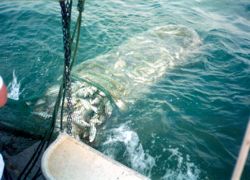VIMS to begin new ecosystem management study
For years, fisheries within Chesapeake Bay have been managed on a species-by-species basis, with management plans that do not take into account factors such as the abundance of competitors, predators, and forage species.
Now, a funding commitment of $629,000 from the Virginia Environmental Endowment (VEE), will allow scientists at VIMS to launch an innovative three-year project that will focus on developing a model for multi-species management of sustainable fisheries within Chesapeake Bay. This new approach will consider the entire ecosystem and be based on the development of a food-web model for the lower Chesapeake Bay.
Scientists know that population levels of commercially important fishes are greatly affected by the abundance of their prey, their predators, and their competitors. These relationships change over the life history of a species, and can be greatly influenced by the environment. Fishing, as well as environmental fluctuations, can seriously alter community structure, impacting the abundance of predator and prey species.
 “The delineation and understanding of such interactions are
critical to the sustainable management of the lower Bay ecosystem,” says VIMS
professor John Graves. “The award from the Virginia Environmental Endowment
provides us with a unique opportunity to develop a model that will allow
fishery managers to forecast the impacts of various actions on the ecosystem as
a whole”
“The delineation and understanding of such interactions are
critical to the sustainable management of the lower Bay ecosystem,” says VIMS
professor John Graves. “The award from the Virginia Environmental Endowment
provides us with a unique opportunity to develop a model that will allow
fishery managers to forecast the impacts of various actions on the ecosystem as
a whole”
This work will build on VIMS Juvenile Trawl Survey, a 46-year series monitoring the abundance of juvenile fishes in Chesapeake Bay and tributaries and some environmental conditions. The project will be coordinated with researchers at other institutions on the Bay who are also working on various aspects of the food web within Chesapeake Bay.
Ultimately, these data will be used to develop a more comprehensive model for fishery managers, allowing them to predict the outcome of various scenarios. For example, striped bass populations are currently up. What impact do elevated levels of striped bass have on prey species such as bay anchovy, blue crab, and menhaden? How do these impacts affect other species such as bluefish, red drum, and weakfish that also feed on bay anchovy, blue crab, and menhaden?
Scientists feel that some of the data necessary to understand these kinds of food-web interactions are not known. As the model is developed, the needs for further food web research will be highlighted.
“Building a dynamic model will force us to take inventory, to see where information is needed to develop predictive capabilities,” says VIMS professor Richard Wetzel, a co-director of the project.
The grant from the Virginia Environmental Endowment will also permit researchers at VIMS to update the Status of Stocks and Species Information, which they developed in 1995. The original document, which included a synopsis of information on important recreational fishes of Chesapeake Bay, will be revised and expanded to include data on the feeding habits and relationships of many important forage species, as well as several non-resident species in the lower Chesapeake Bay. This document will be available on the VIMS web site.
Gerald P. McCarthy, Executive Director of Virginia Environmental Endowment, says that “This work will enable scientists to develop the knowledge and applications needed by managers to make decisions based on a complex and far more complete suite of information.”
He says that the ultimate goal of the work is to develop an ecosystem-based fisheries management plan with models that will provide better tools to forecast the impact of a management act or environmental event on a particular species as well as on the ecosystem as a whole. Sustainable fisheries are essential to maintain ecological, economic, and social benefits provided by the resources.
McCarthy said that VIMS has just the right combination of experience, skills, and information to undertake this important and groundbreaking work. “This initiative will eventually change the way the fisheries of the Chesapeake Bay are managed, and allow for the possibility of sustainable fisheries in the Bay for generations to come.”
He added, “VIMS is taking a leadership role in coordinating the scientific work on sustainable fisheries research in the Bay. They are inviting their colleagues to work cooperatively so that the Living Resources goals of the Chesapeake 2000 Agreement may be reached. The Endowment is very excited at this new direction and honored to be able to help.”
